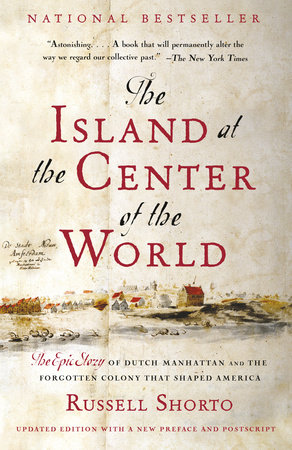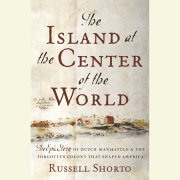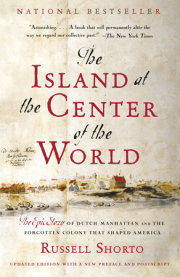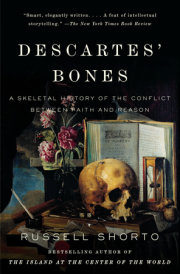Chapter 1
THE MEASURE OF THINGS
On a late summer's day in the year 1608, a gentleman of London made his way across that city. He was a man of ambition, intellect, arrogance, and drive--in short, a man of his age. Like our own, his was an era of expanding horizons and a rapidly shrinking world, in which the pursuit of individual dreams led to new discoveries, which in turn led to newer and bigger dreams. His complicated personality--including periodic fits of brooding passivity that all but incapacitated him--was built around an impressive self-confidence, and at this moment he was almost certainly convinced that the meeting he was headed toward would be of historic importance.
He walked west, in the direction of St. Paul's Cathedral, which then, as now, dominated the skyline. But the structure in the distance was not the St. Paul's of today, the serene, imperial building that signifies order and human reason, with the spirit of the Renaissance and the Enlightenment shining from its proud dome. His St. Paul's had a hunkering tower in place of a dome (the steeple that had originally risen from the tower had been struck by lightning almost half a century before and hadn't been replaced); it was a dark, medieval church, which suited the medieval market town that London still was in the early seventeenth century. The streets through which he walked were narrow, shadowy, claustrophobic, sloping toward central sewer ditches. The houses that lined them were built of timber and walled with wattle and daub--it was a city made chiefly of wood.
Since we know his destination and have some notion of the whereabouts of his house, it is possible to trace a likely route that Henry Hudson, ship's captain, would have taken on that summer day, on his way to meet with the directors of the Muscovy Company, funders of voyages of exploration and discovery. The widest thoroughfare from Tower Street Ward toward Cordwainer Street Ward was Tower Street. He would have passed first through a neighborhood that, despite being within sight of the scaffold and gallows of the Tower itself, was an area of relatively new, "divers fair and large houses," as John Stow, a contemporary chronicler, described, several of them owned by prominent noblemen.
On his left then came the dominating church of St. Dunstan in the East, and a reminder of his heritage. The Muscovy Company had not only funded at least two of Henry Hudson's previous sea voyages; going back through its history of half a century, it contained several Hudsons on its rolls. Among its charter members in 1555 was another Henry Hudson, who rose from a humble "skinner," or tanner, to become a wealthy member of society and an alderman of the City of London, and who may have been the explorer's grandfather. So our Henry Hudson was presumably born to the sea and to the company both, and inside the church he was now passing, his Muscovy Company namesake lay, beneath a gilded alabaster stone inscribed:
Here lyeth Henry Heardsons corps,
Within this Tombe of Stone:
His Soule (through faith in Christ's death,)
to God in Heaven is gone.
Whiles that he lived an Alderman,
And Skinner was his state:
To Vertue bare hee all his love,
To vice he bare his hate.
If in his walk the seaman chose to detour down the hill past the church, he would have come to the open expanse of the Thames, where the view west downriver was dominated by the span of London Bridge with its twenty stone arches, houses perched precariously along both sides of its course. Directly across the river, beckoning lowly and enticingly, lay Southwark, a wild outland and thus also the entertainment district, with brothels tucked into its alleys and, visible from here, the "bear bayting" arena, which provided one of the most popular distractions for the masses. Beyond it stood the rounded wooden structure of the Globe Theater in its original incarnation. Indeed, somewhere over on the Southwark side at this very moment, amid the tradesmen, whores, "sturdye Beggers," and "Common Players in Enterludes" that populated the borough, Shakespeare himself--at forty-four a near-exact contemporary of Hudson, then at the height of his powers and fame as the leading dramatist of the day--was likely going about his business, sleeping off a night of sack at the Mermaid with his actor friends Richard Burbage and John Heminge, maybe, or brooding over the foolscap sheets of Coriolanus, which was written about this time and which, coming on the heels of the great tragedies, may have felt a bit hollow.
Tower Street became Little Eastcheap, which in turn merged into Candlewick and then Budge Row. Hudson's business lay here, in an imposing building called Muscovy House, home of the Muscovy Company. The medieval look of the London of 1608 belied the fact that England's rise to global empire was under way, and one of the forces behind that rise lay through these doors. From the bravado of its formal name--the "Merchants Adventurers of England for the Discovery of Lands, Territories, Iles, Dominions, and Seigniories Unknown"--one might be excused for thinking it had been founded out of sheer, unstoppable exuberance. The original band of merchants and aristocrats who had formed it more than half a century earlier included many of the most distinguished men in London in the middle of the sixteenth century--the Lord High Treasurer, the Steward of the Queen's Household, the Keeper of the Privy Seal, the Lord High Admiral--as well as sundry other knights and gentlemen. But while global exploration, the great intellectual and business opportunity of the day, had brought them all together, no one considered the undertaking a swashbuckling adventure. It was desperation that drove them toward new horizons. The England of the 1540s had been a backwater, economically depressed, inward-looking, deep in the shadows of the great maritime empires of Spain and Portugal. Wool was the country's chief commodity, but English traders had been blocked from access to major European markets for more than a century. Economic stagnation was bound up with intellectual stagnation: while the Renaissance was in full flower on the Continent, English interest in the wider world was slim, and the few long voyages of exploration England had mounted were mostly led by foreigners, such as the Venetian John Cabot (ne Giovanni Cabotto). When it came to sea voyages, the English declined.
History traditionally links the rise of England in the period with the elevation of Queen Elizabeth to the throne in 1558. But one could trace it to 1547, when an intellectually voracious twenty-year-old named John Dee did something countless students since have done: spent his summer abroad and returned flush with new knowledge and insights. After an academic career at Cambridge in which he proved to be something of a mathematical genius, Dee traveled to the University of Louvain in what is today Belgium. The rich summer sun of the Brabant region might have been revelation enough, but Dee soon found himself in a lecture hall gazing at an object that was, to him, transcendent. The teacher was Gemma Frisius, a Flemish mathematician and charter of the heavens, and what Dee saw was a map astonishing in its level of detail, in the new lands it portrayed, even in its lettering. The Low Countries, he discovered, were miles ahead of his island in new learning.
Dee spent long candle-lit nights poring over Frisius's maps with a Flemish scholar named Gerhard Kremer. Kremer, an engraver by training, had, under the academic pen name of Mercator, begun to make a name for himself ten years earlier by creating a map of Palestine that rendered the Holy Land with greater accuracy than had ever been achieved. Mercator was a genuine Renaissance man--a master cartographer, an engineer of telescopes, sextants, surveying equipment, and other highly sensitive measuring devices, the author of a gospel concordance, promoter of the new italic typeface that made map print more legible--and in him Dee found a soul mate. In 1569, Mercator would publish the map that would give him his immortality, which rendered latitude and longitude as straight lines, the meridians of longitude evenly spaced and the distance between the parallels of latitude increasing in size as one approached the poles. It would solve a cumbersome problem of navigating at sea because with it sailors could plot and follow a straight course rather than have to constantly recalculate their position. (The Mercator projection is still a feature of navigational maps, although, even at that time, some mariners were as confused as later generations of schoolchildren would be by the distortions in size it caused.)
In a nice foreshadowing of the complicated intermingling between the Low Countries and the British Isles that would shape the next century, when Dee returned to London he brought with him maps, measuring instruments, and globes, created by Mercator and Frisius, that would help spark England's rise to global prominence. What Dee's English colleagues found most intriguing about the maps and globes was an area most people would ignore: the top, the Arctic Circle. Frisius's map, oriented as if looking down from the north star, showed a distinct open channel cutting across the Arctic, which was self-confidently labeled in Latin Fretum trium fratrum. The sight of the boldly indicated Strait of the Three Brothers must have made Dee's English friends gasp. The Holy Grail for all learned and adventuresome minds was the discovery of a short passage to the riches of Asia. Finding it would repay investors many times over; for the English, it would vault their economy out of the Middle Ages and into the European vanguard. The legend of the Strait of the Three Brothers was confused even at that time, but it appears to have been based on the adventures of the Corte Real brothers, Portuguese mariners who explored the area around Newfoundland at the beginning of the sixteenth century, and who, in the minds of some, sighted, or perhaps even sailed, the fabled passage to Asia before two of them vanished into Arctic oblivion. (Ironically, the Spanish also had a theory about this mythical strait, only they called it the Englishmen's Strait.) Now there it was on Frisius's map, thanks apparently to Frisius's contacts with Portuguese mariners. It was on Mercator's globe as well, labeled simply fretum arcticum, arctic strait. As with most people in any endeavor, seeing the thing in print, seeing its coasts and coves delicately but decisively rendered, confirmed its reality.
Fate, it seemed, had brought together the men, the means, and the time. The solution to England's twin crises of economy and spirit was out there. So the nation's leaders formed a business circle, chipping in twenty-five pounds per share and raising a total of six thousand pounds.
With the principals lined up and funds ready, it only remained to choose the likeliest route--either the one indicated on Frisius's map or one of several others that were now being put forth with equal confidence. The point was to find a northern passage both because such a shortcut would render obsolete the Spanish and Portuguese monopoly on the Southern Hemisphere and because any northern peoples encountered along the way would be more likely buyers for English wool. That an Arctic sea route existed was beyond anyone's doubt. The universal belief among the intelligentsia in something we know to be a physical impossibility in wooden sailing vessels rested on several arguments, such as the one put forth by the Dutch minister and geographer Peter Plancius that "near the pole the sun shines for five months continually; and although his rays are weak, yet on account of the long time they continue, they have sufficient strength to warm the ground, to render it temperate, to accommodate it for the habitation of men, and to produce grass for the nourishment of animals."
The name by which the company became known gives away what happened on the first voyage it financed. A doughty mariner named Richard Chancellor took the northeast route, and while he failed to discover a passage to the Orient, he became the first Englishman of the era to make landfall at Russia. The so-called Muscovy trade that ensued--in which the English found a ready market for their wool, and imported hemp, sperm oil, and furs from the realm of Ivan the Terrible--was so profitable that the search for a northern route to Asia was largely abandoned.
The company expanded, and the nation with it. Elizabeth ascended to the throne; Drake circumnavigated the globe; Shakespeare wrote. When, in 1588, Philip II of Spain launched an invasion fleet toward England, intending to bring the island into his empire and win its people back to Roman Catholicism, the undersized English navy shocked the world by crushing the Armada. The aftermath of the victory was one of those moments when a nation suddenly realizes it has entered a new era. Theirs wasn't a dark and chilly island after all, the English public was informed by their great poet, but a "precious stone set in the silver sea."
By the early 1600s, however, the wheel had taken another turn. The queen was dead, and the Russia trade had fallen off. Faced once again with financial crisis, the company's directors made a decision to return to their original purpose. They would resurrect the Renaissance dream, commit themselves anew to discovering a northern passage to Asia.
The man they now turned to to renew the quest is not the protagonist of this story, but the forerunner, the one who would make it possible. In the ranks of legendary explorers, Henry Hudson has been slighted: not celebrated in his time by the English public as Francis Drake or Martin Frobisher or John Cabot had been, not given nearly the amount of ink that history has devoted to Columbus or Magellan. There is a logic of personality in this: Drake had defined manhood for an era, and the Italian Cabot had a feckless charm (he was in the habit, after his celebrated return from the New World, of promising people he met in taverns that he would name islands for them), but when we come to Henry Hudson it is a dark and moody figure hovering behind the records, one seemingly more comfortable in the shadows of history. A new appreciation for the Dutch colony in North America, however, compels a reappraisal of the man whose fitful decision-making rerouted the flow of history.
Nothing is known of his early career, but the fact that he was a ship's captain indicates that he had had a lengthy one by the time we encounter him in 1608. It's reasonable to assume that he had served in the defeat of the Armada twenty years earlier, though we have no information on this. The Muscovy Company tended to start apprentices as boys and have them work through one or more aspects of the business: bureaucrat, "factor" (i.e., agent), or sailor. Thus, one Christopher Hudson, who rose to the position of governor of the company from 1601 to 1607 and whom some historians have thought was most likely Henry Hudson's uncle, had worked his way up in the sales and marketing line, serving as a company representative in Germany in his youth. Henry Hudson was in his forties when he stepped into the light of history, a seasoned mariner, a man with a strong and resourceful wife and three sons, a man born and raised not only to the sea but to the quest for a northern passage to Asia, who, weaned from infancy on the legends of his predecessors, probably couldn't help but be obsessed by it.
Copyright © 2004 by Russell Shorto. All rights reserved. No part of this excerpt may be reproduced or reprinted without permission in writing from the publisher.












